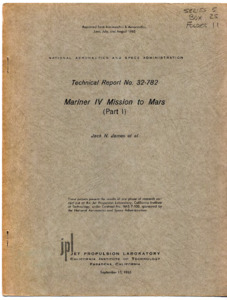
Saunders Kramer Collection
Dublin Core
Identifier
Saunders Kramer Collection
Title
Saunders Kramer Collection
Description
Saunders B. Kramer, a scientist and engineer, was born on October 30, 1920, and died on May 30, 2005. Born and raised in Brooklyn, N.Y., he graduated from Brooklyn’s Polytechnic University with a bachelor’s degree in physics in 1951, and a master’s degree in applied mathematics in 1952.
Kramer served in the Army during World War II and worked at Sperry Gyroscope Co, a New York defense contractor, before joining the Lockheed Corporation. Kramer worked on aerospace projects and on improving the efficiency of automobile engines and was an authority on the Soviet space program. From 1955 to 1971, he worked for Lockheed Corporation in Sunnyvale, California, on a variety of early aerospace projects. He was director of the first detailed study of a manned space station and an early space shuttle. In 1960, Kramer received one of the first patents for a design of a space station.
At Lockheed, Kramer was involved in several NASA studies on the submarine-launched Polaris missile. For many years, he collected and analyzed data on satellite and spacecraft launchings, developing considerable expertise in the Soviet space program. Kramer, who was known as “Sandy,” came to Washington in 1975 as a scientist with the Department of Energy, conducting research into designing automobile engines to reduce pollution and improve mechanical efficiency. He served as a consultant to the U.S military and other federal agencies.
Kramer wrote dozens of technical papers on space exploration, delivered hundreds of lectures, and published the book “The Hundred Billion New-Ruble Trip: A Russian Landing on Mars” in 2003. Additionally, he co-authored a children’s book on the Discoverer satellite. Kramer was contributing editor to Air & Space Magazine; he frequently had his letters published in Aviation and Aeronautics publications, and he was often quoted in newspaper and magazine stories about space travel and exploration.
Saunders B. Kramer was a founding member of the American Astronautical Society, a fellow of the British Interplanetary Society, and a member of the Planetary Society and National Space Society.
Kramer served in the Army during World War II and worked at Sperry Gyroscope Co, a New York defense contractor, before joining the Lockheed Corporation. Kramer worked on aerospace projects and on improving the efficiency of automobile engines and was an authority on the Soviet space program. From 1955 to 1971, he worked for Lockheed Corporation in Sunnyvale, California, on a variety of early aerospace projects. He was director of the first detailed study of a manned space station and an early space shuttle. In 1960, Kramer received one of the first patents for a design of a space station.
At Lockheed, Kramer was involved in several NASA studies on the submarine-launched Polaris missile. For many years, he collected and analyzed data on satellite and spacecraft launchings, developing considerable expertise in the Soviet space program. Kramer, who was known as “Sandy,” came to Washington in 1975 as a scientist with the Department of Energy, conducting research into designing automobile engines to reduce pollution and improve mechanical efficiency. He served as a consultant to the U.S military and other federal agencies.
Kramer wrote dozens of technical papers on space exploration, delivered hundreds of lectures, and published the book “The Hundred Billion New-Ruble Trip: A Russian Landing on Mars” in 2003. Additionally, he co-authored a children’s book on the Discoverer satellite. Kramer was contributing editor to Air & Space Magazine; he frequently had his letters published in Aviation and Aeronautics publications, and he was often quoted in newspaper and magazine stories about space travel and exploration.
Saunders B. Kramer was a founding member of the American Astronautical Society, a fellow of the British Interplanetary Society, and a member of the Planetary Society and National Space Society.
Collection Tree
- Space Collections
- Saunders Kramer Collection
